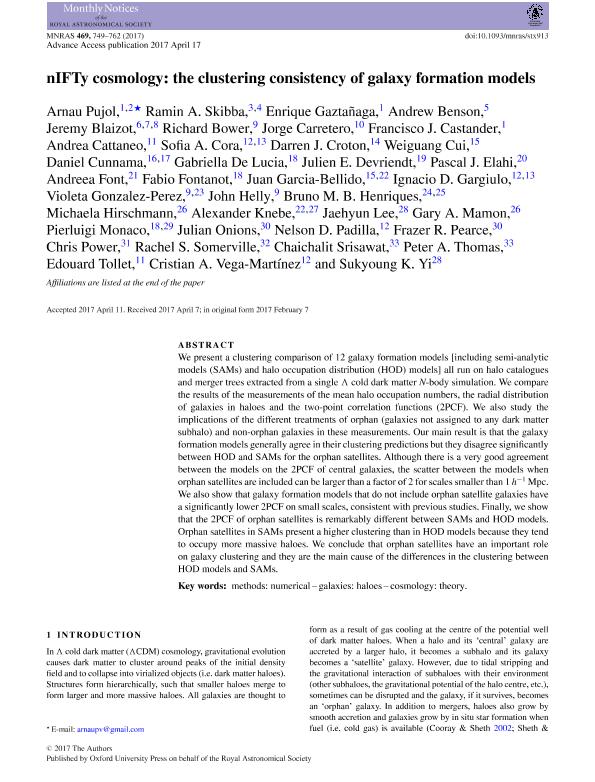Artículo
nIFTy cosmology: The clustering consistency of galaxy formation models
Pujol, Arnau; Skibba, Ramin A.; Gaztañaga, Enrique; Benson, Andrew; Blaizot, Jeremy; Bower, Richard; Carretero, Jorge; Castander, Francisco J.; Cattaneo, Andrea; Cora, Sofia Alejandra ; Croton, Darren J.; Cui, Weiguang; Cunnama, Daniel; De Lucia, Gabriella; Devriendt, Julien E.; Elahi, Pascal J.; Font, Andreea; Fontanot, Fabio; Garcia Bellido, Juan; Gargiulo, Ignacio Daniel
; Croton, Darren J.; Cui, Weiguang; Cunnama, Daniel; De Lucia, Gabriella; Devriendt, Julien E.; Elahi, Pascal J.; Font, Andreea; Fontanot, Fabio; Garcia Bellido, Juan; Gargiulo, Ignacio Daniel ; Gonzalez Perez, Violeta; Helly, John; Henriques, Bruno M. B.; Hirschmann, Michaela; Knebe, Alexander; Lee, Jaehyun; Mamon, Gary A.; Monaco, Pierluigi; Onions, Julian; Padilla, Nelson David
; Gonzalez Perez, Violeta; Helly, John; Henriques, Bruno M. B.; Hirschmann, Michaela; Knebe, Alexander; Lee, Jaehyun; Mamon, Gary A.; Monaco, Pierluigi; Onions, Julian; Padilla, Nelson David ; Pearce, Frazer R.; Power, Chris; Somerville, Rachel S.; Srisawat, Chaichalit; Thomas, Peter A.; Tollet, Edouard; Vega Martínez, Cristian Antonio
; Pearce, Frazer R.; Power, Chris; Somerville, Rachel S.; Srisawat, Chaichalit; Thomas, Peter A.; Tollet, Edouard; Vega Martínez, Cristian Antonio ; Yi, Sukyoung K.
; Yi, Sukyoung K.
 ; Croton, Darren J.; Cui, Weiguang; Cunnama, Daniel; De Lucia, Gabriella; Devriendt, Julien E.; Elahi, Pascal J.; Font, Andreea; Fontanot, Fabio; Garcia Bellido, Juan; Gargiulo, Ignacio Daniel
; Croton, Darren J.; Cui, Weiguang; Cunnama, Daniel; De Lucia, Gabriella; Devriendt, Julien E.; Elahi, Pascal J.; Font, Andreea; Fontanot, Fabio; Garcia Bellido, Juan; Gargiulo, Ignacio Daniel ; Gonzalez Perez, Violeta; Helly, John; Henriques, Bruno M. B.; Hirschmann, Michaela; Knebe, Alexander; Lee, Jaehyun; Mamon, Gary A.; Monaco, Pierluigi; Onions, Julian; Padilla, Nelson David
; Gonzalez Perez, Violeta; Helly, John; Henriques, Bruno M. B.; Hirschmann, Michaela; Knebe, Alexander; Lee, Jaehyun; Mamon, Gary A.; Monaco, Pierluigi; Onions, Julian; Padilla, Nelson David ; Pearce, Frazer R.; Power, Chris; Somerville, Rachel S.; Srisawat, Chaichalit; Thomas, Peter A.; Tollet, Edouard; Vega Martínez, Cristian Antonio
; Pearce, Frazer R.; Power, Chris; Somerville, Rachel S.; Srisawat, Chaichalit; Thomas, Peter A.; Tollet, Edouard; Vega Martínez, Cristian Antonio ; Yi, Sukyoung K.
; Yi, Sukyoung K.
Fecha de publicación:
07/2017
Editorial:
Wiley Blackwell Publishing, Inc
Revista:
Monthly Notices of the Royal Astronomical Society
ISSN:
0035-8711
Idioma:
Inglés
Tipo de recurso:
Artículo publicado
Clasificación temática:
Resumen
We present a clustering comparison of 12 galaxy formation models [including semi-analytic models (SAMs) and halo occupation distribution (HOD) models] all run on halo catalogues and merger trees extracted from a single Λ cold dark matter N-body simulation. We compare the results of the measurements of the mean halo occupation numbers, the radial distribution of galaxies in haloes and the two-point correlation functions (2PCF). We also study the implications of the different treatments of orphan (galaxies not assigned to any dark matter subhalo) and non-orphan galaxies in these measurements. Our main result is that the galaxy formation models generally agree in their clustering predictions but they disagree significantly between HOD and SAMs for the orphan satellites. Although there is a very good agreement between the models on the 2PCF of central galaxies, the scatter between the models when orphan satellites are included can be larger than a factor of 2 for scales smaller than 1 h-1 Mpc. We also show that galaxy formation models that do not include orphan satellite galaxies have a significantly lower 2PCF on small scales, consistent with previous studies. Finally, we show that the 2PCF of orphan satellites is remarkably different between SAMs and HOD models. Orphan satellites in SAMs present a higher clustering than in HOD models because they tend to occupy more massive haloes. We conclude that orphan satellites have an important role on galaxy clustering and they are the main cause of the differences in the clustering between HOD models and SAMs.
Palabras clave:
Cosmology: Theory
,
Galaxies: Haloes
,
Methods: Numerical
Archivos asociados
Licencia
Identificadores
Colecciones
Articulos(IALP)
Articulos de INST.DE ASTROFISICA LA PLATA
Articulos de INST.DE ASTROFISICA LA PLATA
Citación
Pujol, Arnau; Skibba, Ramin A.; Gaztañaga, Enrique; Benson, Andrew; Blaizot, Jeremy; et al.; nIFTy cosmology: The clustering consistency of galaxy formation models; Wiley Blackwell Publishing, Inc; Monthly Notices of the Royal Astronomical Society; 469; 1; 7-2017; 749-762
Compartir
Altmétricas



